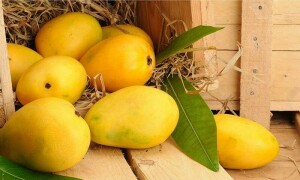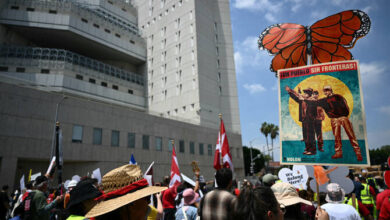The agonising wait for mangoes is over as soon as the king of fruit — especially the fully ripened and delicious Sindhri — is set to reach markets by the first week of June. Summer marks the ripening of mangoes’ taste, colour, and shape; therefore, most orchards witness picking in June, though some start as early as the third week of May in a bid to capitalise on early access to the market.
This year’s crop size is generally fairly good and in healthy shape. However, seasonal pests like hoppers and Thrips did some damage in areas like Tando Allahyar and Mirpurkhas, where malformation is recorded, according to orchards and mango producers’ reports.
According to researchers, owners who manage their orchards personally instead of outsourcing them are always able to control the pests. However, contractors who handle orchards annually for selling crops don’t take it that seriously, and hence, problems arise.
“A mango tree needs pruning of its branches to avoid pests that will make their presence felt if carelessness is observed,” says Wali Mohammad Baloch, executive director of Sindh Horticulture Research Institute (SHRI) in Mirpurkhas. “The crop is by and large good, and we didn’t find a negative or serious impact on the health of the fruit generally,” he continued while attributing malformation to weather conditions triggered by climate change.
Although winter ended in March, the weather remained cloudy, which is not ideal for mangoes. Hot winds didn’t begin to blow in time due to the extended winter. This affected flowering and fruit set in trees,” Mr Baloch says.
The temperature required for growth eluded mangoes even until late March, delaying flowering and fruiting. The impact of winter is pronounced almost everywhere, and according to Nadeem Shah, a veteran mango grower from Matiari, this phenomenon has led to delayed fruit setting in trees this year.
“Due to the northern winds that visited my orchards, the fruit set started late, but the trees on the southern side of the orchard received the required hot winds and thus flowered on time. For me, it is strange,” he says.
Mango harvesting begins in the eastern part of Sindh in Jhuddo and Naukot first — the tail-end of Mirpurkhas district bordering the desert region of Tharparkar. Varieties like Saroli, Almas, Daseri and Langra are picked here for transportation to the Punjab province, mainly to mark the season’s commencement.
Karamullah Saand from Tando Jan Mohammad says, that a 10 kilogram box of Saseri from his orchard was sold for Rs900 to Rs1,100 while a 10kg wooden box of top-quality Sindhri sold for Rs3,500 on average in the Multan district.
“We picked Saroli around April 27 and 28,” he informs. Hoppers were controlled via back-to-back sprays in his outsourced 275-acre orchard, but he personally handled fertiliser application and pest control to protect the orchard. “The winter season extending everywhere remains conducive for hoppers because mercury levels didn’t rise even in April, which is unusual,” he says.
Rasool Bux Memon, a contractor and orchard owner, however, notes that unripe Saroli and Daseri were picked and sold prematurely in Karachi’s market, which didn’t set a good trend for market price-wise in Sindh. “A 10-12kg Daseri box was sold in Faisalabad for Rs1,300,” he says.
Meanwhile, pest attacks are reported in the Tando Allahyar region, and Mahmood Nawaz Shah, President of the Sindh Abadgar Board (SAB), feels pest attacks are becoming a norm in mangoes ahead of harvesting as he has faced this problem again at his mango orchard.
Tando Allahyar, a lower Sindh district on the left bank of the Indus River, is famous for its fertile land and its rich and large mango orchards. Tando Allahyar-based orchard owner Imdad Nizamani notes that the hopper is, surprisingly, restricted mostly to Tando Allahyar or Mirpurkhas, and a research-based initiative is needed to find out the cause.
He suggests it is due to the older age of farms that are susceptible to pests, “Tando Allahyar is a lush green area and home of Sindhri mangoes, and I believe climate change is probably one of the causes of this problem.”
Meanwhile, fruit exports are allowed from May 20 — earlier than in past years. From mango producers’ point of view, this might positively impact the domestic market if quality fruit exports pay dividends. If fruit doesn’t get a better price on the grounds of bad quality, this may also negatively impact the local market, where prices may go down.
This year, exporters aim to export 100,000 tonnes of mango. Abdul Waheed, Patron in chief of All Pakistan Fruits and Vegetables Exporters Association, believes mango production may record a drop of 15-20pc in Sindh while 40-45pc in Punjab, the province that contributes 70pc of total mangoes. He feels climate change-induced weather patterns are becoming more evident in mango production now.
“If fruit quality is affected, this means its health, taste and shape are hit, and in this case, it doesn’t fetch a good price,” Mr Waheed says while underscoring the need for research-based initiatives at government levels to come up with a solution for growers so that they can tackle pests and manage farms with preventive measures.
Sindhri picking will be in full swing in lower Sindh orchards by the first week of June. The variety is exported in larger volumes to Gulf countries and Iran.
A progressive mango grower, Ghulam Sarwar Abro, manages a hot water treatment facility—a prerequisite for exports in many countries—at his Thatta farm and encourages farmers to export to make themselves an extra buck.
However, Mr Abro insists this is only possible if growers seriously pay attention to their orchards instead of outsourcing them. “Growers can handle issues at the production stage with a little investment and care,” he says.
The export of fruit is starting somewhat earlier this year on May 20. From mango producers’ point of view, this might have a positive impact on the domestic market. The export of quality fruits certainly pays dividends.
If fruit doesn’t get a better price due to quality issues, the local market will be impacted negatively, and prices may record a downward trend. Consumers, meanwhile, hope they can have inexpensive mangoes in these days of inflation.







